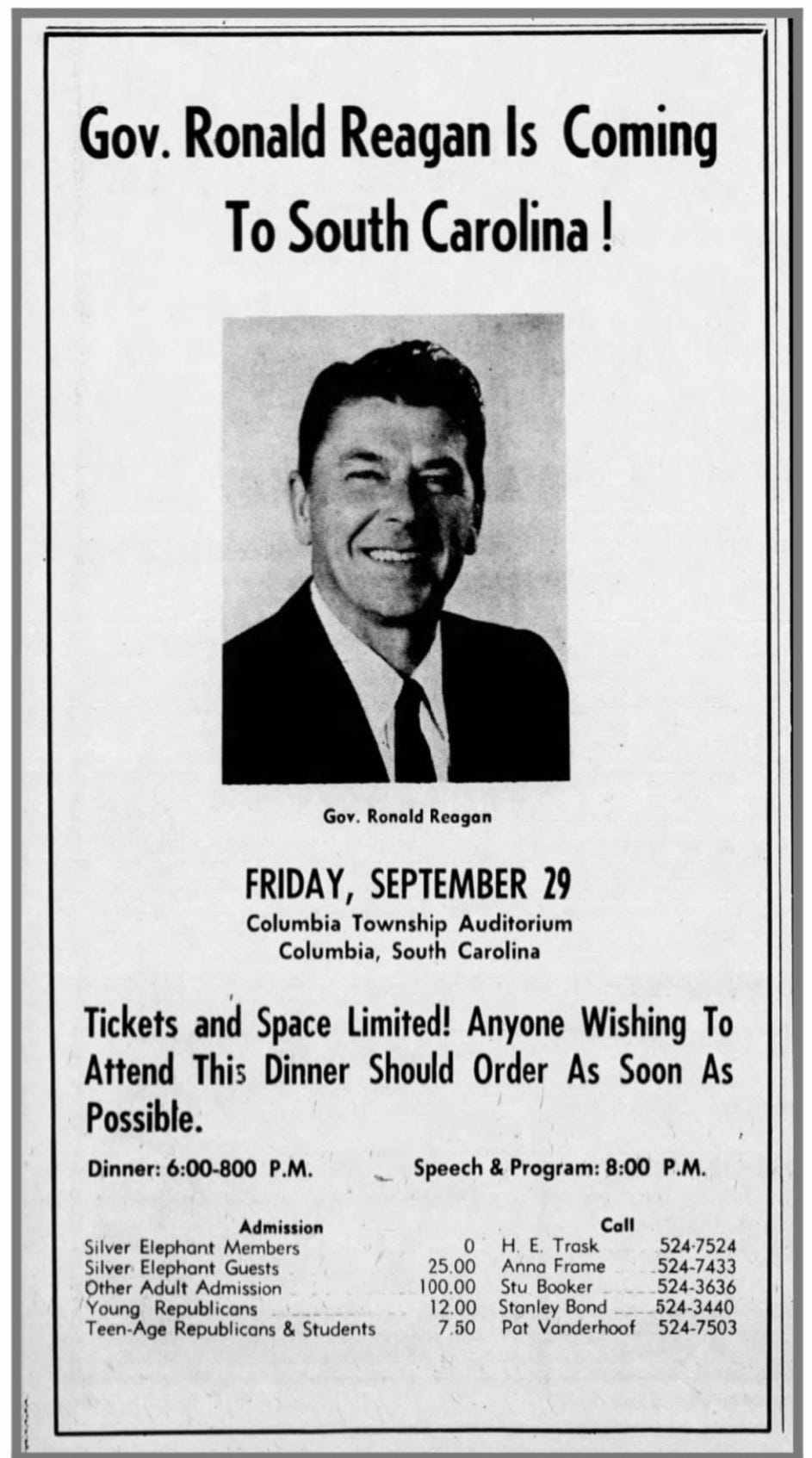Debt holds the whole thing together
Student loans, medical bankruptcy, and other disciplinary tools for workers
I’ll confess to feeling a thrill over the last week as I watched conservative politicians go cross-eyed and froth at the mouth about the Biden administration’s modest student loan forgiveness order.
My personal favorite came from South Carolina Gov. Henry McMaster, whose statements I always read in the voice of Frank Underwood on a Quaalude bender. He said:
Thread by thread, President Biden and the liberal Democrats are destroying the fabric of this great nation. A fabric that has held this great nation together for almost two hundred and fifty years.
The American Dream of prosperity and happiness - achieved through hard work, self-reliance, and playing by the rules - is being threatened by the liberal left’s “something-for-nothing” entitlement culture of handouts, bailouts, and cop outs.
Setting aside that tuition was literally $520 when ol’ Hank graduated from the University of South Carolina in 1969 — and setting aside that Henry is also a landlord whose derelict college apartment rental empire is the epitome of money-for-nothing — I agree with my governor in a limited sense.
Debt is the fabric that holds this country together. But destroying that fabric is a good thing.
Debt binds us to our employers, keeps us from taking risks to improve our station in life, 1 and siphons our wealth to a rentier class. People with debts to pay will work multiple jobs, pick up extra shifts, and give their labor to the “gig economy.” Debt disciplines us as workers. 2
From indentured servitude to sharecropping to company stores to title loans and check advances, debt really is what keeps this country from falling apart if you think about it. The threat of financial ruination from medical bills keeps us tied to employers just so we can stay on an insurance plan. We’re living in one of the wealthiest countries in human history, and we lead the developed world in medical debt bankruptcies. What a sick joke.
Henry and I live in a state with widespread poverty, and some of the most viable and politically well-connected businesses are predatory payday lenders who lock people into cycles of debt with exorbitant interest rates. When Mick Mulvaney was in Congress and the Trump White House, his office consistently carried out the agenda of these lenders and would practically write press releases for the South Carolina-based payday lender Advance America. One of the wealthiest living South Carolinians, Ben Navarro, runs a company called Sherman Financial Group that ramped up debt collections on poor people during the first year of the COVID-19 pandemic.
To the extent that forgiving $10,000 of education debt frays the fabric that binds us in predatory and abusive relationships, I say we keep tugging at the threads until the whole damn thing unravels.
Another one of my favorite fussy babies this past week was Rep. Jim Banks (R-Indiana), who said:
Student loan forgiveness undermines one of our military’s greatest recruitment tools at a time of dangerously low enlistments
He’s not wrong! Debt, or the threat of debt, is a leading factor that motivates people to enlist. 3
Many, many other people have pointed this out already, but if we need the looming specter of catastrophic debt to prod people into joining the armed forces, then maybe we need to come up with better incentives. Better yet, if we’re having staffing problems, why not increase benefits for enlisted folks, close some of our 750-plus overseas bases, and shrink our ever-ballooning War Department budget?
There is plenty of blame to go around for the student debt crisis in this country, but first and foremost I blame policies of austerity pushed by national and state politicians of both parties since the Reagan Revolution of the 1980s. As states cut higher-education funding down to the bone, tuition costs soared to make up for it.
Before he became governor of California in the late 1960s, the University of California system was practically free to attend. That combined with open-admissions policies for in-state students at some state institutions made California a leader in open access to education.
Reagan ran for governor in 1966 on a culture-war platform that sounds eerily familiar today. He complained about taxes, spoke ominously about sexual revolution on campus, blamed youth liberalism on outside agitators, and vowed to “clean up the mess at Berkeley.”

Fifteen days after taking the governor’s office in January 1967, he was already whining about his critics portraying him as anti-intellectual.
“In all the sound and fury of the budget discussion of recent days,” Reagan said on Jan. 17, 1967, “this administration has been portrayed as an opponent of educational ideas engaged in total warfare against the academic community ... I think it’s time to put the entire picture in focus and reestablish a sensible and realistic perspective.”
Gov. Reagan called his critics “hysterical.”
“[W]e made it plain that tuition must be accompanied by adequate loans to be paid back after graduation,” he reassured the public. This logic was echoed in the National Review, which proposed a “system of full tuition charges supplemented by loans which students must pay out of their future income.”
Almost immediately after taking office, Reagan took a brickbat to the state university system. Dissent magazine reported in its Fall 2012 issue:
He cut state funding for higher education, laid the foundations for a shift to a tuition-based funding model, and called in the National Guard to crush student protest, which it did with unprecedented severity. But he was only able to do this because he had already successfully shifted the political debate over the meaning and purpose of public higher education in America. The first “bums” he threw off welfare were California university students. Instead of seeing the education of the state’s youth as a patriotic duty and a vital weapon in the Cold War, he cast universities as a problem in and of themselves—both an expensive welfare program and dangerously close to socialism. He even argued for the importance of tuition-based funding by suggesting that if students had to pay, they’d value their education too much to protest.
In May 1970, during student protests against the Vietnam War and the U.S. bombing of Cambodia, Reagan forced all 28 campuses of UC and Cal State to close temporarily. Reagan’s war on education was coming to a head.
Gov. Reagan was running for re-election in the fall of 1970 when one of his education advisors, Stanford University Prof. Roger A. Freeman, famously said this at a press conference in Reagan’s defense:
We are in danger of producing an educated proletariat. That’s dynamite! We have to be selective on who we allow to go through (higher education). If not, we will have a large number of highly trained and unemployed people. That’s what happened in Germany. I saw it happen.
As Jon Schwarz wrote in The Intercept recently, the only cost to attend UC-Berkeley in 1968 was a $300 yearly fee. Right now, total yearly student costs are close to $40,000. The Reagan governorship was a turning point.
States make their own decisions on higher education funding, but it’s remarkable how so many followed the path of Reagan’s California. Here in South Carolina, we had a proud tradition of open admissions and free tuition dating back to Reconstruction, but that had already been whittled down during Jim Crow to exclude Black students. When the federal government forced the University of South Carolina to start admitting Black students again, university leaders became regional trailblazers in the use of selective admissions based on standardized tests, working explicitly to exclude as many Black students as possible.
South Carolina also began strangling its own universities through a decades-long project of austerity. With a Republican trifecta in charge of the state budget in the years following the 2008 recession, South Carolina slashed its funding for higher education more than most — and still hasn’t restored funding to pre-2008 levels. Today at the flagship University of South Carolina, the state provides less than 10% of the budget. The school makes up the difference by hiking tuition and recruiting out-of-state students who pay a higher rate.
The net price of attendance at a public four-year university in South Carolina was 36% of the state’s median household income, according to a 2019 analysis by the Center on Budget and Policy Priorities. That was the highest percentage of any state in the country.
The price of a college education is financially ruinous for most South Carolinians. Postsecondary education, once a path to knowledge and prosperity, has become an anchor around the necks of the poor. It is against this backdrop that our governor moralizes about “something-for-nothing” and the fabric of the country.
My friend John Warner has taught for more than 20 years at schools including Clemson University and the College of Charleston, where he has worked with students battling both the educational and financial deficits imposed on them by the state. Beyond debt forgiveness, his proposal to resolve our structural failures is simple: Higher education should be free for everyone.
He writes in his 2020 book Sustainable. Resilient Free. The Future of Public Higher Education:
Having embraced the ethos of the market, we have managed to reduce the value of a postsecondary education entirely to its credential, while simultaneously leaving institutions starved of the revenue necessary to do the work.
The state has imposed the inhuman logic of capital on teachers and students, and our politicians have the gall to lecture us on the morality of taking on debt. We are bound in the fabric that they wove, and we won’t get free until we rip it apart from the inside.
***
In the newsletter Forward Notion, Farris Steele wrote a stunning essay last week on debt, mutual aid, and false narratives of scarcity. Farris writes from experience as a first-generation college grad and Pell Grant recipient. I highly recommend it.
For Banned Books Week this year, I’ll be co-hosting a free public panel on the state of censorship in South Carolina at Itinerant Literate Books in North Charleston. Mark your calendar for Thursday, Sept. 22, at 7 p.m. I’ll be joined by local educators AJ Davis, Loni Lewis, and possibly one other guest. For more details, see the Eventbrite page.
Brutal South is a free newsletter about education, class struggle, and religion in the American South. If you would like to support my work, get some cool stickers in the mail, and read / listen to some subscriber-only content, paid subscriptions are $5 a month.
Bookshop // Twitter // Bandcamp // Apple Podcasts // Spotify Podcasts
The Conversation, August 2022: “When approximately 10,000 student loan borrowers had their private student loans randomly canceled from 2010 to 2017, researchers found that it ultimately enabled them to more easily move, change jobs and earn more money. The borrowers were also 11% less likely to default on credit cards or other loans.”
Critical Sociology, 2014: “Far from an archaic or non-capitalist social relation, debt bondage must be understood as a profitable strategy of labor discipline anchored in state regulatory frameworks that have bolstered the power of employers and facilitated predatory and privatized forms of credit and lending as solutions to poverty and unemployment.”
Jacobin, April 2022: “Each year, the Department of Defense mails out a ‘Futures Survey’ in an effort to understand the likelihood of military enlistment in people age sixteen to twenty-four. Results of the survey are clear: young people see the military as a way to pay for college. Over half of the respondents as recently as fall 2020 reported that funding education would be a motivating factor in enlistment, and respondents approaching college age (sixteen to eighteen) felt more certain about enlistment than any other age group surveyed.”





